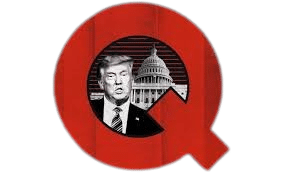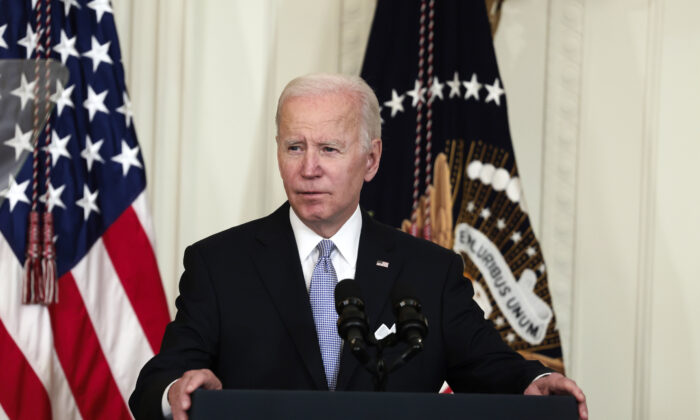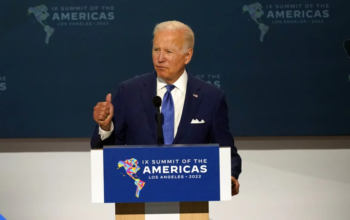The Biden administration’s dramatic expansion of the role of the federal government in business, banking, and society, and sharp break from the deregulatory approach of the Trump presidency, has severely overburdened key sectors and industries of the U.S. economy and helped drive up inflation to the highest rate in four decades, experts say.
The federal budget deficit for the first six months of fiscal year 2022 was $667 billion, according to Congressional Budget Office (CBO) figures. The CBO expects a deficit of $1 trillion for fiscal year 2022 as a whole. This figure represents a decline from the $2.7 trillion recorded for 2021, but by the CBO’s own admission, the decrease is largely a result of lowered spending on COVID-19 relief as the pandemic wanes. Over the long term, the CBO fully expects the deficit to rise to 6.1 percent of gross domestic product (GDP) by 2032 if current trends hold, a threshold surpassed only six times since 1946.
This lopsided forecast is largely attributable to regulation and its effects on incomes and investment, experts say. With a radically different attitude toward government and its role from that of former President Donald Trump, President Joe Biden’s administration has rolled out one of the most aggressive regulatory expansions in U.S. history, imposing a sweeping array of new rules and statutes, and broadening existing ones, through a blend of executive orders and rulemaking. The regulations involve areas as varied as energy procurement, gas pipelines, environmental policy, immigration and refugee resettlement, COVID-19 relief, the use of drones, gun laws, healthcare, the minimum wage, and the status of transgender persons.
Some of the regulations drafted and implemented under Biden are new initiatives, while others are explicitly conceived as efforts to counteract and overturn Trump-era rules, guidelines, and laws, and set public policy in the United States in a different direction. Whatever their origin and purpose, experts argue that the current administration’s regulatory activity is harming the economy both in the short and long term.
In July 2021, the spending habits of the new administration drew attention when reports emerged that Biden would spend more than $200 million on White House staff alone, compared to the $164.3 million and $188.5 million White House payrolls under Presidents Trump and Obama, respectively. But massive federal programs and regulations are what really concern some economists at the present juncture.
“There is no doubt that regulations imposed on individuals and businesses increase costs. These can include direct implementation costs and compliance costs (time and resources associated with internal controls and monitoring),” said Jeffrey Guernsey, a professor of finance and assistant dean of the School for Business Administration at Cedarville University in Ohio.
The burden of regulations was onerous even before the new administration took office and began rolling out its unprecedented expansion. Guernsey cites a 2020 report prepared by the Competitive Enterprise Institute (CEI) think tank, which found that federal regulations cost an estimated $1.9 trillion annually, which breaks down to more than $14,000 per household every year. That burden will only grow with the stepped-up regulation.
Tax compliance is a leading contributor to the burdens afflicting businesses and individuals. Guernsey noted that the cost of IRS regulations in 2016, the last year of the Obama administration, stood at $409 billion, according to a Tax Foundation report. The same report noted that complying with IRS paperwork takes up 8.9 billion hours of Americans’ time in a given year.
Shackling the Economy
“The general effect of regulation is to depress the economy. Heavy regulation discourages entrepreneurship and investment and raises the cost of producing the goods and services people need,” said Charles Steele, a professor of economics at Hillsdale College.
In Steele’s view, much of the new regulation that comes into play does so without a great deal of transparency, because federal regulators are well aware of the possible consequences of letting outside observers see the full extent of what they propose to do and how much it will cost.
“Federal regulators have typically opposed attempts to impose independent benefit-cost analyses of regulations, as well as sunset rules for regulations that fail such tests. If there are analyses, they prefer to do them in-house, using data and procedures not available to external reviewers. I think they are aware that serious benefit-cost tests would greatly reduce their power,” Steele said.
Steele contrasted the orientation of the current administration with that of President Trump, who undertook what Steele views as a highly credible effort to deregulate, which led to the United States achieving energy independence for the first time in decades. The Biden administration has reversed course, he said. Current trends may well lead to what economists refer to as “secular stagflation,” or in other words, decreased economic growth and increased inflation over the long term.
Regulating US Energy
An area of particular concern for those following economic trends is the impact of environmental regulations, and especially those affecting energy and fossil fuels of critical importance for industrial, commercial, and residential use, Steele said.
While pipelines offer the least expensive, not to mention the safest, means of transporting oil and gas, the Biden administration has not only blocked oil and gas leases and put statutes in place that make operating pipelines costlier, but has taken such dramatic steps as canceling the Keystone XL pipeline and is currently giving serious thought to shutting down Michigan’s Line 5 pipeline, he noted. The administration has also implemented stricter Corporate Average Fuel Economy (CAFE) standards, which regulate how far new vehicles must travel on a gallon of fuel, he observed.
“Investment in future oil and gas production has collapsed as a result,” Steele said, adding that certain alternatives commonly put forward are not really viable in practice.
“So-called ‘green energy,’ wind and solar, are not sufficiently scalable to replace fossil fuels and have other problems, such as their intermittent nature and the lack of batteries for sufficient storage. If current regulatory trends continue, I think the country will face serious energy shortages soon. These will harm everyone,” Steele said.
Another possibility in the near future is the Biden administration reinstating Waters of the United States (WOTUS), a protocol whose name derives from 1972 amendments to the Clean Water Act. WOTUS broadens the ability of the Environment Protection Agency (EPA) and other federal bodies to regulate vaguely defined “waters” on U.S. territory, Steele said. In Steele’s view, the vagueness of WOTUS is practically an invitation for federal agencies to abuse their authority and overregulate.
“It’s a real threat to ownership of private property in the United States,” he said.
Fueling Inflation
Inflation is running high with food prices up 10.8 percent for the year ending in April 2022, the biggest yearly jump since November 1980, according to Bureau of Labor Statistics figures.
When attempting to understand the forces driving the record-high inflation with consumers are grappling, it is impossible to avoid the subjects of overregulation and federal spending, including the Fed’s buying of Treasury bonds held by banks, which has sharply increased the amounts of loanable cash on hand.
“Our current inflation comes from the Fed keeping a very low federal funds rate and an expansion of the money supply, supposedly to counteract the effects of the pandemic lockdown,” said Steele, who estimates that the M2 money supply—the broadest measure of the amount of the money in the economy—has risen by roughly $6.3 trillion since the United States went into lockdown in the early months of 2020.
“The lockdown prevented economic activity. It doesn’t make sense to try to stimulate economic activity with monetary policy at the same time you’re locking it down, but that’s what the federal government tried to do,” Steele said.
“Now we have supply-chain breakdowns, a lingering effect of the lockdowns, exacerbated by Russia’s invasion of Ukraine and the consequent disruption of energy and food production. The Fed now is boxed into a corner, facing effects of an expanded money supply plus growing supply constraints,” he added.
When the Obama administration began running trillion-dollar deficits, the Federal Reserve paid banks to hold reserves rather than lend them out. This kept the amount of money chasing goods in the economy at relatively low levels and thereby avoid inflation, explained Gary Wolfram, a professor of economics and public policy at Hillsdale College and president of the Hilldale Policy Group, a consulting firm.
But the Federal Reserve’s aggressive buying of Treasury bonds has flooded banks with more loanable cash and changed the dynamic.
“The reserves of banks increased dramatically from about $2 billion in 2008 to $3.8 trillion today and banks recently have begun lending out these reserves. This led to an increase in the money supply on an annual basis of 12.5 percent in February and 11 percent in March, and this is a large reason for the inflation,” Wolfram said.
Easing the Burden
Besides holding off on implementing new regulations and expanding current ones, Steele believes it would be prudent to subject every regulation to a cost-benefit analysis, administered externally rather than within the federal bureaucracies. While not a perfect science, such reviews can provide a sense of just how much benefit a given regulation offers businesses and consumers relative to the burden it imposes. Those regulations found to be unnecessarily onerous would be candidates for scrapping, and all would be subject to reevaluation at 10-year intervals, under Steele’s plan. But the Biden administration has opposed such analyses, he noted.
Such measures would be a step, but a more ambitious undertaking is needed to unfetter the economy. Steele calls for getting rid of what he terms the “regulatory administrative state.”
“It is doubtful that a free society and rule by an unelected administrative state can coexist,” Steele said.
Steele also sees potential for changing the current practice whereby legislators in Congress pass a bill whose particulars are vague, and leave it up to federal agencies to provide the details. This is far from an ideal way to introduce laws, he said.
In Steele’s analysis, those companies that favor heavier regulation tend to be large corporations that can afford it and sometimes play a role in its drafting. Unlike their smaller competitors, such corporations have the budget to hire all the lawyers, economists, and accountants they need, and to position themselves to their advantage in any negotiations over the proposed legislation.
It is no surprise that people frequently cross over between the largest firms and the regulatory agencies, for example between the pharmaceutical industry and the Food and Drug Administration, Steele observed. In effect, the biggest firms are able to “game the system” in their favor while hampering entrepreneurship, he said.
“The use of common law on tort and nuisance should be substituted for regulation, especially on environmental issues. Such law was being developed and was proving effective, until the regulatory agencies were empowered to override it in the 1970s,” Steele said.
Source: The Epoch Times




